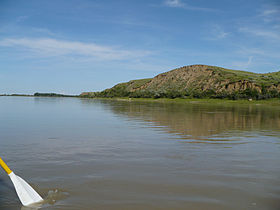The Missouri River is in United States of America.

The Missouri--Mississippi River system forms the United States' longest stream. It was the route of the Lewis and Clark expedition, Native Americans, fur traders, steamboats and railroads.
Understand
[edit]The Missouri is navigable by canoe and/or powerboat from Headwaters State Park near Three Forks, however there are 8 dams between Toston and Fort Benton. Some of these dams are quite extensive and difficult to portage. Great Falls until just above Fort Benton white water conditions apply and it is generally only navigable by raft or other whitewater type boats. From the traditional head of steamboat navigation at Fort Benton, Montana to where it joins the Mississippi River at Saint Louis is mainly free of obstruction.
Below Fort Benton it is possible to float by canoe or powerboat the entire length. However the river is a series of alternating free floating stretches interrupted by lakes backed up behind major dams. Often it is necessary to portage around the dams. Generally the free flowing areas and lakes are 150 miles or longer. Thus any particular segment makes a very reasonable trip. Some segments are more suitable for powerboats, some more suitable for canoes.
Primitive camping along the river is generally necessary, although there are many towns with fancier accommodations. Legal access to campsites is possible in the entire Montana portion. Missouri has an extensive water trail program with designated campsites every few miles. Policies in the other states vary. Check carefully before going.
Prepare
[edit]Careful preparation and planning is necessary. Much of the river through Montana and the Dakotas is very remote and you will be entirely dependent on your own resources. Cell phone coverage varies from non--existent to spotty. Find out boating and camping regulations.
Make sure you have the proper boat and equipment and know how to use it. Carry adequate drinking and cooking water. Mark Twain is reputed to have said "The Missouri River is too thick to drink, and too thin to plow." Aside from the river's heavy silt load, there may be runoff containing agricultural chemicals.
Montana Stream Access Law ([dead link])- "all water capable of recreational use can be so used by the public (between the ordinary high water marks) without regard to the ownership of the land underlying the waters." If you are going to do any boating in Montana, this law will clarify your rights and responsibilities.
Get in
[edit]It is possible to get to selected launching points by highway. Some points are quite close to airports or Amtrak routes. Outfitters or marinas may be able to arrange boats and pickup or drop off service on the river.
Boating
[edit]Upper Missouri River Breaks National Monument[dead link]
Starting at Fort Benton, Montana: 150 miles of free flowing river through spectacular badlands. Powerboats are very restricted, but canoe outfitters are abundant.
Fort Peck Lake
The 130 mile lake behind Fort Peck Dam is entirely within the Charles M. Russell National Wildlife Area. Marinas with powerboats are available at the town of Fort Peck. Both powerboats and canoes will need to portage around the dam. Camping is allowed on the shore of the lake.
Fort Peck, Montana to Williston, North Dakota
This free flowing 150 mile reach is often too shallow for powerboats. It flows through beautiful prairie country. Scenic snags (logs) and shallow sandbanks are common. There are no known canoe outfitters for this reach, but if you can outfit yourself, it is possible to shuttle between Glascow or Wolf Point, Montana and Williston by Amtrak.
Access from the river is possible to the small towns of Poplar and Brockton Montana, located in the Fort Peck Indian Reservation. Fort Union National Monument's large U.S. flag is visible at the North Dakota border. Slightly further downstream at the confluence of the Yellowstone River is Fort Buford. Both of these reconstructed 19th century forts are worth a visit.
Lake Sakakawea [dead link] North Dakota
Lake Sakakawea to Bismarck North Dakota
Lake Oahe [dead link]
Stay safe
[edit]Much of the river is very remote. River hazards include strong currents, sand bars, snags, dams, and bad weather--particularly thunder storms. Off river hazards include poisonous snakes, insects, changing water levels, and possibly crime in the lower more urban reaches. The lower 800 miles of the river may have heavy barge traffic.

